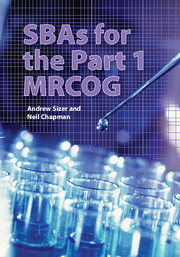Book contents
- Frontmatter
- Contents
- Preface
- About the authors
- Acknowledgements
- Abbreviations
- Foreword
- How to use this book
- 1 Structure and content of the Part 1 MRCOG examination
- 2 Part 1 MRCOG blueprinting matrix, syllabus topics and example questions for paper 1
- 3 Part 1 MRCOG blueprinting matrix, syllabus topics and example questions for paper 2
- 4 Mock paper: paper 1
- 5 Mock paper: paper 2
- Appendix 1 Blueprinting matrix for the Part 1 MRCOG examination
- Appendix 2 Example SBA answer sheet
- Appendix 3 Answers to chapter 2 questions
- Appendix 4 Answers to chapter 3 questions
- Appendix 5 Answers to mock paper 1 (chapter 4)
- Appendix 6 Answers to mock paper 2 (chapter 5)
1 - Structure and content of the Part 1 MRCOG examination
Published online by Cambridge University Press: 05 July 2014
- Frontmatter
- Contents
- Preface
- About the authors
- Acknowledgements
- Abbreviations
- Foreword
- How to use this book
- 1 Structure and content of the Part 1 MRCOG examination
- 2 Part 1 MRCOG blueprinting matrix, syllabus topics and example questions for paper 1
- 3 Part 1 MRCOG blueprinting matrix, syllabus topics and example questions for paper 2
- 4 Mock paper: paper 1
- 5 Mock paper: paper 2
- Appendix 1 Blueprinting matrix for the Part 1 MRCOG examination
- Appendix 2 Example SBA answer sheet
- Appendix 3 Answers to chapter 2 questions
- Appendix 4 Answers to chapter 3 questions
- Appendix 5 Answers to mock paper 1 (chapter 4)
- Appendix 6 Answers to mock paper 2 (chapter 5)
Summary
From March 2012, there will be some significant changes to both the syllabus and examination style for the Part 1 MRCOG examination. These changes have been ratified by the General Medical Council and aim to produce an examination that is more relevant to the 21st century trainee aspiring to have a career in obstetrics and gynaecology.
Essentially, the changes to the Part 1 MRCOG entail a shift of emphasis to ensure that the examination continues to provide a relevant foundation for the continuation of learning and the development objectives of the specialty training programme. This change has required a realignment of the proportional contribution of existing areas of the Part 1 MRCOG syllabus and a revised blueprinting exercise that references explicitly the modules of the core curriculum against the existing global question domains. The modification of the existing examination format will ensure that this revised syllabus coverage can be tested appropriately to reflect the new desired emphasis of the Part 1 MRCOG.
The new Part 1 MRCOG contains questions that are clearly relevant to an applied sciences examination in obstetrics and gynaecology, with less of a focus on de-contextualised fundamental science. In essence, the new examination still requires candidates to have a robust understanding of fundamental science, both physical and biomedical, which will serve as a foundation on which to build subsequent clinical knowledge. The major difference from the previous examination is that knowledge is tested in a more clinical context to ensure candidates have the appropriate knowledge to function as specialty trainees on a daily basis.
- Type
- Chapter
- Information
- SBAs for the Part 1 MRCOG , pp. 1 - 6Publisher: Cambridge University PressPrint publication year: 2012



